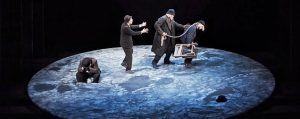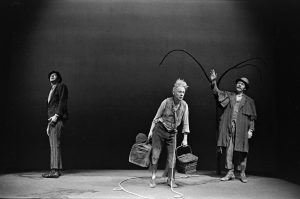Module 2
What is Godot about and what made it so ground-breaking?

Gary Lydon (Estragon), Conor Lovett (Vladimir), Tadgh Murphy (Lucky) and Gavan O’Herlihy (Pozzo) in Gare St Lazare Players/Dublin Theatre Festival production of Waiting For Godot directed by Judy Hegarty Lovett (2014).
What happens in the play where ‘nothing happens twice’?
Two tramps, Vladimir (Didi) and Estragon (Gogo) wait on a country road for Mr Godot to arrive. To pass the time they play games and contemplate their existence. Pozzo and Lucky, a master and slave duo, arrive and help Vladimir and Estragon to pass the time. In Act 2, the same dynamics continue to play out. Vladimir and Estragon continue to wait for Godot’s arrival but are ultimately left in the same hopeful yet unknowing situation as that in which the play began.
So waiting, as the title of the play suggests, is what the play is about: the audience, like Didi and Gogo, are waiting for something to happen, for time to pass, till the end of the play.
Think about a time when you have been waiting for something or someone: how did it affect your experience of time itself?
When he saw the English language premiere of the play at the Arts Theatre London in 1955, the renowned British theatre critic, Kenneth Tynan wrote that: ‘Passing the time in the dark, [Beckett] suggests, is not only what drama is about, but what life is about’ (The Observer, 7 August 1955). The meaning of the play is conveyed through the audience’s theatrical experience of it, including the fact that Godot the play and Godot the character, raise more questions than they answer.
Godot according to Beckett
On 17 February 1952 an abridged version of Godot was performed in the studio of the Club d’Essai de la Radio and was then broadcast on French radio. Beckett, who notoriously avoided being recorded, did not turn up to this recording to introduce the work and sent a polite note for Roger Blin to read out instead (see: Knowlson, 1996, 386; 394). Part of his introduction reads:
I don’t know who Godot is. I don’t even know (above all don’t know) if he exists. And I don’t know if they believe in him or not – those two who are waiting for him. The other two pass by towards the end of each of the two acts, that must be to break up the monotony. All I knew I showed. It’s not much, but it’s enough for me, by a wide margin. I’ll even say that I would have been satisfied with less. As for wanting to find in all that a broader, loftier meaning to carry away from the performance, along with the program and the Eskimo pie, I cannot see the point of it. But it must be possible . . . Estragon, Vladimir, Pozzo, Lucky, their time and their space, I was able to know them a little but far from the need to understand. Maybe they owe you explanations. Let them supply it. Without me. They and I are through with each other. (See: Ruby Cohn in James and Elizabeth Knowlson, 2006, 122)
Later, when Alan Schneider, who directed the first American production of Godotin 1956, asked Beckett who or what he meant by Godot, the playwright said: ‘If I knew, I would have said so in the play.’ (Schneider, 1958)
So part of the experience of the play, is not knowing all the answers. Or rather, it is up to each audience member (or reader) to ponder what the play is about, including who Godot is, and why Didi and Gogo keep waiting for him.
In his online essay ‘An Introduction to Waiting for Godot’ for the British Library, Chris Power suggests that: ‘The first step towards engaging with the play is accepting that it won’t supply solutions to its mysteries’. You will find his discussion of Godot useful with some great images.
Placing the audience in the same position of uncertainty as his central characters is just one of the ways in which Beckett was crafting a new model of theatre, one which a) focused not on powerful or influential characters and their social milieu, but on the experience of the marginalised and the dispossessed and b) focused less on traditional techniques of plot and narrative, and more on the present moment, on the fundamental experience of being in time, and on how we depend on and interact with those around us. Yet as humans we are beings in search of meaning and significance, so in Waiting for Godot, Beckett created an interplay of patterns and motifs that readers or audience members can interpret for themselves.
Beckett directed the play himself at the Schiller-Theater in Berlin in 1975. Although he had overseen several productions, this was the first time he took complete control. It’s also worth noting that a young Walter Asmus, who would go on to direct many Beckett productions, was his assistant director. Click here for the Staging Beckett interview with Asmus.
Beckett said of directing Godot:
It is a game, everything is a game. When all four of them are lying on the ground, that cannot be handled naturalistically. That has got to be done artificially, balletically. Otherwise everything becomes an imitation, an imitation of reality. […] It should become clear and transparent, not dry. It is a game in order to survive. (Beckett in Gontarski, 2012, 213)

Beckett’s Schiller Godot on its UK tour to the Royal Court in 1976. Carl Raddatz (Pozzo), Klaus Herm (Lucky), Stefan Wigger (Vladimir). See the Staging Beckett database for more info on this Beckett-directed production that toured to the Royal Court Theatre in 1976. © Douglas Jeffery Collection, Victoria and Albert Museum, London.
Clearly Beckett was onto something new with the shape of and ideas behind Godot, but what makes it so ground-breaking? Katherine Weiss offers some thoughts on the originality of the play when she explains that Godot is a rejection of the theatrical conventions that produced it:
While plays prior to Waiting for Godot embodied a central conflict, reached a climax and ended with a resolution, Waiting for Godot subverts the audience’s expectations for a climax (Godot’s arrival) and a resolution (Didi’s and Gogo’s salvation or damnation). Rather, the conflicts in this play are the language games Didi and Gogo take part in and the master-slave relationship of Pozzo and Lucky. While Godot does not come as the audience expects, and Didi and Gogo hope, Didi and Gogo are visited by Pozzo and his slave Lucky. (Weiss, 2012, 15-6)
By not locating the play in a specific time and place, Beckett could focus on the interrelationships and interdependencies of his characters, including the power relationships between them, that have enabled the play to speak to many different historical and social / political contexts.
Thinking Point:
In your opinion, what makes Waiting for Godot such a ground-breaking play?
Thinking Further:
How do Beckett’s comments to Walter Asmus that Godot ‘cannot be handled naturalistically’ and that ‘it is a game in order to survive’ help us understand the style and shape of the play?
Further reading:
For a discussion of Beckett’s production, see: Ciaran Ross, ‘Beckett’s Godot in Berlin: New Coordinates of the Void’, Samuel Beckett Today / Aujourd’hui, 11, Endlessness in the Year 2000 (2001), 64-73.























